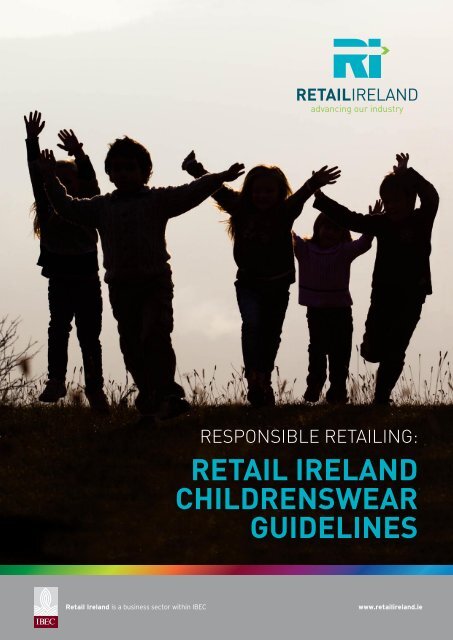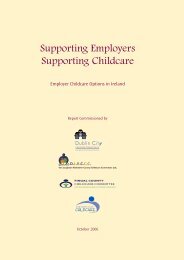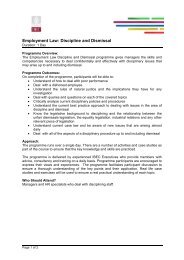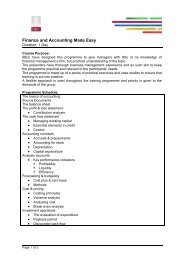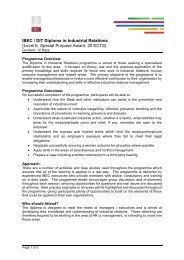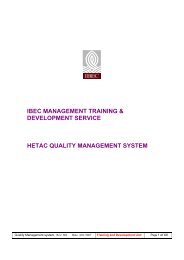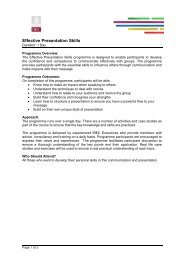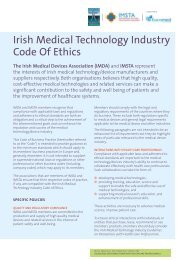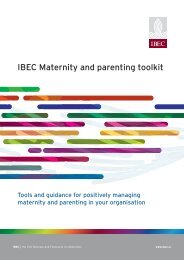retail ireland childrenswear guidelines - Irish Business and ...
retail ireland childrenswear guidelines - Irish Business and ...
retail ireland childrenswear guidelines - Irish Business and ...
You also want an ePaper? Increase the reach of your titles
YUMPU automatically turns print PDFs into web optimized ePapers that Google loves.
REsponsible Retailing:<br />
Retail Irel<strong>and</strong><br />
Childrenswear<br />
Guidelines<br />
Retail Irel<strong>and</strong> is a business sector within IBEC<br />
www.<strong>retail</strong><strong>irel<strong>and</strong></strong>.ie
Welcome by Director<br />
of Retail Irel<strong>and</strong><br />
Stephen Lynam<br />
Forword by Minister for<br />
Children <strong>and</strong> Youth Affairs<br />
Frances Fitzgerald TD<br />
Unlike other sectors of <strong>Irish</strong> industry, <strong>retail</strong>ers are<br />
located in every community, every town <strong>and</strong> every<br />
city in Irel<strong>and</strong>. Being so connected makes the<br />
<strong>retail</strong> sector particularly aware of the concerns of<br />
consumers <strong>and</strong> imbues <strong>retail</strong>ers with a keen sense<br />
of responsibility to the customers they serve <strong>and</strong><br />
the communities in which they operate.<br />
This code of practice has been drawn up against<br />
a changing national <strong>and</strong> international backdrop.<br />
In Irel<strong>and</strong>, the establishment of the Department<br />
of Children <strong>and</strong> Youth Affairs, with a m<strong>and</strong>ate to<br />
protect children <strong>and</strong> protect childhood, has been<br />
welcomed in all quarters. Everyone has a role to<br />
play in ensuring the department can deliver on its<br />
promises to children.<br />
The adoption in 2011 of best practice <strong>guidelines</strong> for<br />
the <strong>retail</strong>ing of children’s clothing in the UK by our<br />
colleagues in the British Retail Consortium (BRC)<br />
was another welcome development. Many Retail<br />
Irel<strong>and</strong> members are themselves members of the<br />
BRC <strong>and</strong> their <strong>Irish</strong> operations already adhere to<br />
those <strong>guidelines</strong>. Others, while not BRC members,<br />
adhere to the principles contained within.<br />
This confluence of events- a renewed political<br />
impetus to ensure children are protected,<br />
together with the adoption of <strong>guidelines</strong> relating<br />
to <strong>childrenswear</strong> in the UK- has led Retail Irel<strong>and</strong><br />
members to demonstrate the products they offer<br />
meet their customers’ expectations of quality,<br />
price, style <strong>and</strong> taste by similar <strong>guidelines</strong> for the<br />
sale of <strong>childrenswear</strong> in this market.<br />
Retail Irel<strong>and</strong> now invites all chidrenswear<br />
<strong>retail</strong>ers in Irel<strong>and</strong> to join us, become signatories<br />
to these <strong>guidelines</strong> <strong>and</strong> offer <strong>childrenswear</strong> that<br />
is practical, age appropriate, <strong>and</strong> fun, to suit<br />
everyone’s budgets.<br />
As Minister for Children <strong>and</strong> Youth Affairs I am<br />
delighted to endorse Retail Irel<strong>and</strong> Childrenswear<br />
Guidelines.<br />
Since taking office I have begun implementing a<br />
series of measures to enhance Irel<strong>and</strong>’s culture of<br />
child protection <strong>and</strong> preserving the special space<br />
that is childhood. But safeguarding our children<br />
<strong>and</strong> protecting childhood is a task which falls to<br />
all of society, to everybody in the community. We<br />
all have a responsibility <strong>and</strong> in this spirit I believe<br />
there is a role for the <strong>retail</strong> sector.<br />
Earlier this year I extended an invitation to the<br />
<strong>Irish</strong> fashion <strong>retail</strong> sector to develop a set of<br />
<strong>guidelines</strong> on the <strong>retail</strong>ing of <strong>childrenswear</strong> in<br />
Irel<strong>and</strong>, similar to those prepared by the British<br />
Retail Consortium. I wish to thank Retail Irel<strong>and</strong><br />
for accepting my invitation <strong>and</strong> preparing these<br />
<strong>guidelines</strong>. I hope that all <strong>Irish</strong> <strong>childrenswear</strong><br />
<strong>retail</strong>ers will now sign-up.<br />
It is important to note that these <strong>guidelines</strong> are not<br />
just about restricting what <strong>retail</strong>ers can sell, but<br />
instead provide a more constructive guidance on<br />
best practice on a range of issues such as styling,<br />
age-appropriateness, size, labelling <strong>and</strong> marketing.<br />
I believe this code will play an important role in<br />
informing future decision-making, for example on<br />
the appropriateness of new <strong>and</strong> emerging fashion<br />
trends for children, while further providing a<br />
framework within which <strong>retail</strong>ers can responsibly<br />
consider <strong>and</strong> respond to growing concerns over<br />
body-image among children.<br />
The preparation of these <strong>guidelines</strong> is yet another<br />
example of how working together we can, as<br />
a State <strong>and</strong> society, help to foster a culture<br />
where childhood is preserved <strong>and</strong> children are<br />
protected.<br />
00 REsponsible Retailing: Retail Irel<strong>and</strong> Childrenswear Guidelines
Introduction<br />
These voluntary <strong>guidelines</strong> show that Retail<br />
Irel<strong>and</strong> members recognise their responsibilities<br />
by providing age appropriate clothing design<br />
<strong>and</strong> ensuring the marketing of those clothes<br />
to parents is carried out in ways which do not<br />
sexualise or unduly gender stereotype children.<br />
Good <strong>retail</strong>ing involves the provision of what<br />
customers want, when <strong>and</strong> where they want<br />
it <strong>and</strong> at a competitive price. Irel<strong>and</strong>’s <strong>retail</strong><br />
environment is extremely competitive <strong>and</strong> all<br />
<strong>retail</strong>ers take great care to ensure their offer<br />
meets the wishes of their customers. The<br />
customer base of each <strong>retail</strong>er can vary widely,<br />
which means that each <strong>retail</strong>er develops a unique<br />
offering to their customer.<br />
However, all responsible <strong>retail</strong>ers share a common<br />
commitment to deliver the right products in a<br />
way that protects children <strong>and</strong> preserves the<br />
innocence of childhood.<br />
These <strong>guidelines</strong> draw on established good<br />
practice among Retail Irel<strong>and</strong> members. As with<br />
the British Retail Consortium (BRC) <strong>guidelines</strong><br />
already in place in the UK, they act as a framework<br />
within which each <strong>retail</strong>er’s policies are<br />
developed. The <strong>guidelines</strong> are not a replacement<br />
for each individual <strong>retail</strong>er’s best practice in this<br />
area, as their policies will be tailored to meet <strong>and</strong><br />
reflect the specific circumstances of the <strong>retail</strong>er<br />
<strong>and</strong> its customers.<br />
Retail Irel<strong>and</strong><br />
approach<br />
The Retail Irel<strong>and</strong> Childrenswear Guidelines<br />
closely mirror the <strong>guidelines</strong> on <strong>childrenswear</strong><br />
signed in 2011 by members of the BRC. This<br />
makes sense for three reasons;<br />
• The BRC template is seen as an excellent<br />
benchmark of good practice in this area. It<br />
has helped bring about a responsible <strong>and</strong><br />
safe clothing <strong>retail</strong> environment for parents<br />
<strong>and</strong> children, while allowing for choice <strong>and</strong><br />
parental discretion in the matter of choosing<br />
clothes that their children should wear.<br />
• There is a commonality of members between<br />
Retail Irel<strong>and</strong> <strong>and</strong> the BRC <strong>and</strong> therefore a<br />
commonality of existing best practice.<br />
• Ranges <strong>and</strong> styles of children’s clothing are<br />
in many cases common to both markets <strong>and</strong><br />
consumer tastes tend to be similar.<br />
As with the BRC <strong>guidelines</strong>, for the purposes<br />
of the Retail Irel<strong>and</strong> Childrenswear Guidelines,<br />
<strong>childrenswear</strong> means all clothing, footwear <strong>and</strong><br />
accessories designed <strong>and</strong> marketed for children<br />
under the age of twelve years. It does not include<br />
dressing up clothes or toys <strong>and</strong> does not cover<br />
teenage fashion or babywear.<br />
Also, as with the BRC <strong>guidelines</strong>, some of the<br />
issues allow for very clear recommendations<br />
while others are more subjective <strong>and</strong> rely on<br />
individual taste, the circumstances surrounding<br />
the use of a garment <strong>and</strong>/or the age <strong>and</strong> physical<br />
development of the child wearing the garment.<br />
That is why in some cases the <strong>guidelines</strong> outline<br />
clear minimum st<strong>and</strong>ards, while in other cases,<br />
different approaches are acceptable provided<br />
certain concerns are taken into account.<br />
Retail Irel<strong>and</strong> members are of the clear opinion<br />
that operating under these <strong>guidelines</strong> is not<br />
only the right <strong>and</strong> responsible thing to do, but<br />
it is also a commercially sensible course of<br />
action. Retailers operate in a highly competitive<br />
market, <strong>and</strong> rely on the trust <strong>and</strong> respect of their<br />
customers. It will be <strong>Irish</strong> customers who decide<br />
on the acceptability of the clothing ranges on<br />
offer <strong>and</strong> how successfully the signatories are<br />
adhering to these <strong>guidelines</strong>.<br />
Guidelines in this area must be flexible <strong>and</strong><br />
responsive to changing fashions, textiles <strong>and</strong><br />
technologies <strong>and</strong> will be subject to review. Retail<br />
Irel<strong>and</strong> <strong>and</strong> its members will meet regularly to<br />
review their implementation, monitor progress<br />
<strong>and</strong> exchange experiences. We will also, provide<br />
the Minister for Children <strong>and</strong> Youth Affairs with<br />
an annual report outlining what we hope will be<br />
the successful implementation of the <strong>guidelines</strong>.<br />
The initial signatories to this code are Retail<br />
Irel<strong>and</strong> members. We hope that within a short<br />
time more <strong>retail</strong>ers will see the benefits that the<br />
code brings <strong>and</strong> will become signatories. They<br />
are hereby invited to do so.<br />
Any parent, guardian or concerned person who<br />
would like to comment can do so by emailing<br />
<strong>retail</strong>@ibec.ie<br />
REsponsible Retailing: Retail Irel<strong>and</strong> Childrenswear Guidelines<br />
01
Styling<br />
All parents will know that the clothes children<br />
wear need to be suitable for a multitude of uses.<br />
Children attend school, play with their friends<br />
<strong>and</strong> run around their homes <strong>and</strong> gardens – often<br />
on the same day. Childrenswear is also worn on<br />
the beach, in the park <strong>and</strong> by the pool.<br />
These facts determine the choices of styling,<br />
fabric/material, construction <strong>and</strong> colour of<br />
children’s clothes. The age of children for whom<br />
the clothing is designed also determines these<br />
things- as the BRC <strong>guidelines</strong> note, “leggings may<br />
have few age-related design issues whereas dress<br />
necklines may vary to some degree between preschool<br />
children <strong>and</strong> those just pre-teen”.<br />
Existing good practice in <strong>Irish</strong> <strong>retail</strong>ers allows for<br />
internal company consultation on the sizing, cut,<br />
design <strong>and</strong> fashion trend, including the colour,<br />
sheerness <strong>and</strong> pattern of fabrics, as well as the<br />
age appropriateness of children’s clothing.<br />
Slogans<br />
Slogans <strong>and</strong> imagery, including the use of<br />
licensed images <strong>and</strong> br<strong>and</strong>marks, must be<br />
age appropriate <strong>and</strong> not sexually suggestive,<br />
demeaning, derogative or containing political<br />
slogans or images that could be interpreted as<br />
such. Slogans deemed humorous should be tested<br />
against a broad range of views to determine if<br />
they could cause unforeseen <strong>and</strong> unintended<br />
offence. Careful consideration should be given<br />
to what could be described as “gender specific”<br />
slogans.<br />
Modesty<br />
Signatories to these <strong>guidelines</strong> will ensure that<br />
fabrics <strong>and</strong> cut should provide for modesty. As<br />
with the BRC <strong>guidelines</strong>, sheer fabrics without<br />
lining are not acceptable for <strong>childrenswear</strong><br />
bodices or skirts, but may be, with care, on other<br />
parts of the garment. Signatories also undertake<br />
to ensure that the colour, pattern <strong>and</strong> decoration<br />
of children’s garments are chosen with care.<br />
Obviously, <strong>retail</strong>ers must carefully consider<br />
issues such as skirt <strong>and</strong> short length, neck or<br />
shoulder line <strong>and</strong> underwear shape. Retailers<br />
should take into account the stretch properties<br />
of the fabric used in the clothing <strong>and</strong> consider<br />
the intended age group for the clothes.<br />
It is important that children’s clothing ranges<br />
allow all children to be confident about their<br />
developing bodies <strong>and</strong> enjoy play <strong>and</strong> physical<br />
activity while maintaining modesty. For example,<br />
it is likely that for trousers <strong>and</strong> leggings a<br />
single design may be appropriate for all sizes<br />
up to 12 years. However, some styles may need<br />
adjustment to ensure the fit is appropriate for<br />
the intended age - younger <strong>and</strong> older versions<br />
of the same dress style may require a different<br />
neckline.<br />
This is particularly the case for children’s clothing<br />
based on adult fashion trends. Such designs<br />
should be interpreted in an age-appropriate way.<br />
This may result in different choices of cut, fabric<br />
or embellishment. In this regard, particular<br />
attention should be paid to party wear.<br />
Colour<br />
Colour ranges should also be age-appropriate<br />
<strong>and</strong> suitable for the item of clothing. As an<br />
example, black should not be used for first bras,<br />
but may be suitable when included with other<br />
bright colours for knickers or underpants as<br />
long as the <strong>guidelines</strong> for modesty <strong>and</strong> use of<br />
slogans are maintained. However, black would<br />
be perfectly suitable <strong>and</strong> highly practical for<br />
trousers for nearly all ages <strong>and</strong> may in fact be<br />
required for school uniforms. Retailers should<br />
attempt, wherever possible, to provide a choice<br />
of colours, including gender neutral choices.<br />
Underwear<br />
Retailers must show great care when it comes<br />
to the design of underwear. <strong>Irish</strong> <strong>retail</strong>ers who<br />
are signatories to these <strong>guidelines</strong> should<br />
note that, as the BRC <strong>guidelines</strong> state, “simple<br />
decoration <strong>and</strong> a wide choice of colours <strong>and</strong><br />
patterns are welcomed by customers but care<br />
should be exercised to differentiate these from<br />
adult lingerie. Knickers <strong>and</strong> pants must provide<br />
modesty: thongs are not appropriate for children.<br />
Vests <strong>and</strong> crop tops should also be designed for<br />
modesty with no need for structural support in<br />
these garments.”<br />
These <strong>guidelines</strong> also correlate precisely with<br />
the BRC regarding first bras for girls. With the<br />
earlier physical development of children over the<br />
02 REsponsible Retailing: Retail Irel<strong>and</strong> Childrenswear Guidelines
last couple of decades, it is important to offer<br />
well designed <strong>and</strong> supportive first bras to young<br />
girls as their breasts develop. Under-wiring is not<br />
necessary or appropriate for the smallest cup<br />
sizes (eg 28AA) designed as a first bra. Seamfree<br />
designs are particularly suitable, while<br />
giving due regard to cup size <strong>and</strong> the amount of<br />
support needed. First bras should be constructed<br />
to provide comfort, modesty <strong>and</strong> support but not<br />
enhancement. As a guide, the breast shape <strong>and</strong><br />
contour should not be altered significantly when<br />
wearing the bra.<br />
It is the case that parents often express concern<br />
about moulded bra cups <strong>and</strong> where such cups<br />
are used to provide structural support, such as<br />
for larger cup sizes, <strong>retail</strong>ers may find it helpful<br />
to provide their customers with advice to this<br />
effect to help allay their concerns. In the main,<br />
these products will be in teen ranges, rather than<br />
for the Under 12’s.<br />
Swimwear<br />
Swimwear should provide for modesty, including<br />
when wet, <strong>and</strong> should be age appropriate with<br />
children’s needs specifically in mind.<br />
Footwear<br />
In designing footwear for everyday use, the<br />
st<strong>and</strong>ard approach should be to provide a stable,<br />
supporting shoe with a heel pitch (angle of foot)<br />
of generally not more than 2.5cm or one inch.<br />
This is particularly the case for younger children<br />
<strong>and</strong> smaller shoe sizes. Retailers should consider<br />
the likely use of the shoes, such as school or play,<br />
<strong>and</strong> the necessary support <strong>and</strong> stability needed.<br />
Although party shoes, intended for occasional<br />
<strong>and</strong> limited wear, may adopt more sophisticated<br />
styling, they should still provide adequate<br />
stability, avoid excessive heel heights <strong>and</strong> choice<br />
of decoration or embellishment should be ‘pretty’<br />
rather than ‘adult’.<br />
Sizing <strong>and</strong><br />
labelling<br />
Most <strong>Irish</strong> <strong>retail</strong>ers provide parents with<br />
information on the likely age a children’s garment<br />
is suitable for rather than its chest, waist or leg<br />
measurements.<br />
It is of course the case that the height <strong>and</strong> weight<br />
of children of the same age can vary significantly,<br />
which is why it is not uncommon to see <strong>retail</strong>ers<br />
offering up to ‘Age 14’ for larger 11 <strong>and</strong> 12 year<br />
olds, for example. Similar considerations apply<br />
at any Under 12 range break <strong>and</strong> <strong>retail</strong>ers may<br />
consider it appropriate to offer an overlap in<br />
sizes for certain age-specific ranges.<br />
It is appropriate to label garments such as pants,<br />
crop tops, knickers, <strong>and</strong>, usually, swimwear by<br />
age for Under 12s.<br />
Bras<br />
Unlike other types of clothing <strong>and</strong> underwear,<br />
bras should be labelled by bust <strong>and</strong> cup size rather<br />
than by age. Seam free bras may be labelled by<br />
either method depending on how the product is<br />
positioned within the underwear range.<br />
<strong>Irish</strong> <strong>retail</strong>ers are aware that there has been<br />
much criticism <strong>and</strong> more than a little confusion<br />
regarding the use of certain materials <strong>and</strong><br />
constructions in bras for young girls. This<br />
has led to suggestions that these are being<br />
used to provide these bras with padding <strong>and</strong><br />
enhancement. With this in mind, it is helpful to<br />
provide descriptions on labels of first bras such as<br />
‘for support <strong>and</strong> modesty’. As with the BRC code,<br />
no mention should be made of ‘enhancement’ or<br />
‘under-wiring’ in any children’s ranges.<br />
Marketing<br />
Responsible <strong>Irish</strong> <strong>retail</strong>ers do not target their<br />
<strong>childrenswear</strong> marketing at children, but rather<br />
at parents, guardians or adult family friends <strong>and</strong><br />
relatives. This applies to all marketing channels,<br />
be they traditional or new media.<br />
REsponsible Retailing: Retail Irel<strong>and</strong> Childrenswear Guidelines<br />
03
While adopting this approach, it is acceptable<br />
to use child models within certain parameters.<br />
Given the fact that consumption of British media<br />
is common in Irel<strong>and</strong>, it makes sense to follow to<br />
the letter the provisions of the BRC code in this<br />
area;<br />
• Photography should feature children in<br />
natural poses in a childlike environment,<br />
appropriate to the age range concerned.<br />
• Where make up is used it should be as<br />
natural as possible, ensuring the child’s<br />
natural charm comes through in the finished<br />
photograph. This does not preclude the use<br />
of face paints in a play setting, for example.<br />
• The staging of photographs, like the design<br />
of clothing, should encourage children to<br />
develop confidence in their bodies without<br />
pre-conceptions of ‘more desirable’ body<br />
shapes, while supporting the public health<br />
agenda regarding child obesity.<br />
Underwear<br />
Underwear should never be modelled on children<br />
in marketing material produced by <strong>retail</strong>ers,<br />
including on packaging <strong>and</strong> point of sale material.<br />
It is vitally important that websites of <strong>retail</strong>ers<br />
do not include images of children modelling<br />
underwear.<br />
Placement in store<br />
While floor sizes vary from <strong>retail</strong>er to <strong>retail</strong>er,<br />
<strong>and</strong> placement of items can be difficult to<br />
manage, <strong>retail</strong>ers should endeavour to ensure<br />
that ‘adult only’ merch<strong>and</strong>ise is kept as separate<br />
as possible from the <strong>childrenswear</strong> department.<br />
Children’s underwear should be kept within the<br />
<strong>childrenswear</strong> section.<br />
Because of the nature of the garments,<br />
<strong>and</strong> differing physical development of girls<br />
approaching teenage years, bras <strong>and</strong> underwear<br />
for this group pose something of a complication.<br />
Some product ranges may not necessarily fit into<br />
either the children’s section or the adult lingerie<br />
department. In this instance, some <strong>retail</strong>ers may<br />
be in a position to offer professional measuring<br />
<strong>and</strong> fitting services in women’s lingerie. Careful<br />
consideration <strong>and</strong> internal discussions will be<br />
needed to ensure the best approach in general<br />
<strong>and</strong> for a given store.<br />
Online<br />
Particular attention should be paid to <strong>retail</strong>er’s<br />
individual online sites. Digital marketing should<br />
observe the same photography <strong>and</strong> imaging<br />
<strong>guidelines</strong>, considering carefully potential<br />
misuse by others. These <strong>guidelines</strong> state that<br />
internet pathways are clear <strong>and</strong> appropriate for<br />
children who may participate in online shopping<br />
with their parents. Retailers should aim in the<br />
long term to provide website search facilities<br />
that provide the same separation of products as<br />
is delivered in-store.<br />
Internal<br />
communication<br />
<strong>Irish</strong> <strong>retail</strong>ers should have in place policies that<br />
are well understood <strong>and</strong> embraced by staff,<br />
from buyers <strong>and</strong> designers through to those<br />
displaying <strong>and</strong> selling the goods in store. It is up<br />
to individual <strong>retail</strong>ers to properly communicate<br />
these <strong>guidelines</strong> <strong>and</strong> policies in a way that best<br />
suits their own business, but every responsible<br />
<strong>retail</strong>er will have clear internal accountabilities<br />
with an individual acting as ultimate guardian of<br />
<strong>childrenswear</strong> st<strong>and</strong>ards, responsible to company<br />
management.<br />
Customers<br />
<strong>Irish</strong> <strong>retail</strong>ers are responsive to their<br />
customers’ wishes <strong>and</strong> act on feedback from<br />
customers, whether through in-store comment,<br />
correspondence <strong>and</strong> website comments, focus<br />
groups or insight studies. Responsible <strong>retail</strong>ers<br />
give clear signposts on how to raise issues<br />
<strong>and</strong> respond to all types of comments, be they<br />
negative or positive.<br />
Retailers should have systems in place to ensure<br />
that feedback from customers regarding these<br />
<strong>guidelines</strong> should promptly reach the relevant<br />
executive, such as <strong>childrenswear</strong>, commercial<br />
<strong>and</strong> marketing directors.<br />
04 REsponsible Retailing: Retail Irel<strong>and</strong> Childrenswear Guidelines
Product<br />
withdrawal<br />
If, in the rare event that a design makes it to<br />
production <strong>and</strong> <strong>retail</strong>ing without adequate<br />
measures being taken to ensure that it meets the<br />
st<strong>and</strong>ard set out in these <strong>guidelines</strong>, including<br />
modesty, age appropriateness or gender/<br />
body confidence issues of concern to society,<br />
signatories to these <strong>guidelines</strong> will use feedback<br />
from colleagues <strong>and</strong> customers to re-assess<br />
appropriateness. Where the <strong>retail</strong>er decides that<br />
it has not met its usual high st<strong>and</strong>ards in this<br />
regard, it will act swiftly to withdraw the product<br />
from all stores.<br />
Signatories<br />
The following Retail Irel<strong>and</strong> members are<br />
signatories to these <strong>guidelines</strong>;<br />
Reporting <strong>and</strong><br />
oversight<br />
These <strong>guidelines</strong> will be self-enforcing <strong>and</strong><br />
customers are encouraged to help in this process.<br />
Any customer who believes the <strong>guidelines</strong> are<br />
not being adhered to is requested in the first<br />
instance to raise the matter with the manager of<br />
the store in question. If the matter is not resolved<br />
satisfactorily, the customer should provide his/<br />
her feedback centrally to <strong>retail</strong>er management<br />
via the company’s feedback email or telephone<br />
lines, all of which are available on the relevant<br />
signatories’ websites. Customers are also free, at<br />
this point, to provide feedback to <strong>retail</strong>@ibec.ie<br />
<strong>and</strong> the matter will be brought to the relevant<br />
<strong>retail</strong>er’s attention.<br />
All signatories to these <strong>guidelines</strong> will meet<br />
regularly under the Retail Irel<strong>and</strong> umbrella<br />
to discuss implementation. Any feedback or<br />
complaints received by individual <strong>retail</strong>ers will<br />
be compiled on a quarterly basis <strong>and</strong> provided to<br />
the Retail Irel<strong>and</strong> secretariat, which will provide<br />
an annual report on progress to the Minister for<br />
Children <strong>and</strong> Youth Affairs.<br />
REsponsible Retailing: Retail Irel<strong>and</strong> Childrenswear Guidelines<br />
05
RETAIL IRELAND<br />
Confederation House 84/86 Lower Baggot Street Dublin 2<br />
TELEPHONE + 353 (0)1 605 1586 FAX + 353 (0)1 638 1529<br />
E-MAIL <strong>retail</strong>@ibec.ie www.<strong>retail</strong><strong>irel<strong>and</strong></strong>.ie<br />
Retail Irel<strong>and</strong> is a business sector within IBEC<br />
www.ibec.ie<br />
CORK<br />
Knockrea House<br />
Douglas Road<br />
Cork<br />
telephone + 353 (0)21 429 5511<br />
e-mail cork@ibec.ie<br />
SOUTH EAST<br />
Confederation House<br />
Waterford <strong>Business</strong> Park<br />
Cork Road Waterford<br />
telephone + 353 (0)51 331 260<br />
e-mail southeast@ibec.ie<br />
MID-WEST<br />
Gardner House<br />
Bank Place<br />
Charlotte Quay Limerick<br />
telephone + 353 (0)61 410 411<br />
e-mail midwest@ibec.ie<br />
WEST<br />
Ross House<br />
Victoria Place<br />
Galway<br />
telephone + 353 (0)91 561 109<br />
e-mail west@ibec.ie<br />
NORTH WEST<br />
3rd Floor Pier One<br />
Quay Street<br />
Donegal Town<br />
telephone + 353 (0)74 972 2474<br />
e-mail northwest@ibec.ie<br />
IBEC EUROPE<br />
Avenue de Cortenbergh, 89<br />
Boite 2 1000 Bruxelles<br />
Belgium<br />
telephone + 32 (0)2 512 3333<br />
e-mail ibec.europe@ibec.ie<br />
www.ibec.ie/europe


